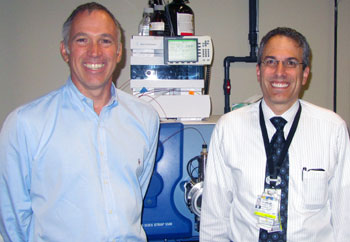Building a Better Drug Test
Startup Plans to Keep Business at Home
By Vicki Hildner
 (November 2013) The brick building on the east end of the Anschutz Medical Campus offers few clues that it houses a startup operation that could bring millions of dollars back to the university.
(November 2013) The brick building on the east end of the Anschutz Medical Campus offers few clues that it houses a startup operation that could bring millions of dollars back to the university.
Inside Bioscience East, the iC42 laboratory, an extension of the Department of Anesthesiology, is churning out detailed drug-test results that make the venture “a game-changer in the field,” according to its co-director Jeffrey Galinkin, MD.
That’s a bold claim, but iC42 is doing some-thing nobody else is: checking in a single test for the presence of more than 100 drugs, even at trace levels. Traditional screenings typically monitor five or six drugs at higher concentrations and require follow-ups to recheck inconclusive results.
The team at iC42 leapt onto a high-stakes field of drug testing in response to the needs of a colleague.
Iñigo San Millán, PhD, director of the Human Performance Laboratory at the Anschutz Health and Wellness Center, trains some of the world’s elite athletes, including Tour de France podium finishers. San Millán works to ensure athletes are not exposed to performance enhancing drugs, but testing for 120 illegal substances can mean 20 separate tests—a difficult, expensive and time-consuming proposition.
When Jose Melendez, MD, and Uwe Christians, MD, PhD, heard about San Millán’s need, they offered iC42’s mass spectrometer as a solution. It could test for more than 100 drugs at a time with complete accuracy.
“We could prove an athlete was clean with one test,” Melendez says.
Melendez, vice chair of clinical affairs for the Department of Anesthesiology, brought motivation and focus to push the project forward within the university. Christians, director of the laboratory, provided expertise and research leadership.
But an obstacle remained: money.
In the spring of 2010, Melendez mentioned the opportunity to his neighbor, Blair Whitaker, in an over-the-fence conversation.
“They had one customer already — athletes,” says Whitaker. “They had the equipment they needed and smart people to put it to use. They just needed a little bit of capital.”
Whitaker, a venture capitalist and business strategist with 30 years’ experience, brought crucial financial support.
Galinkin saw a new market for iC42’s economically priced and accurate drug tests: pain clinics, addiction centers, and any others needing to check and monitor patient drug use.
Galinkin, an anesthesiologist at Children’s Hospital Colorado and professor at the School of Medicine, and Whitaker spent the first half of 2011 studying the market potential and perfecting the test.
By June 2011, iC42 took on its first customer, who brought 89 samples, each to be tested for 112 drugs. But the big launch revealed a big problem. The detailed tests yielded 4,000-page documents for each sample, causing the soft-ware to crash. The manufacturer of the mass spectrometer had no solution.
“We had done something novel; we had pushed the machine to its limits, and now we had the unintended consequences,” Galinkin says.
So Whitaker called on connections he had made in the 1980s doing research at the University of Pennsylvania and MIT and within six months, had a team that developed software offering accessible and understandable data.
“Now, we had it all,” Whitaker says. “We had a large market for our product, the machines to do the tests, the software to produce reports and the scientific and business expertise. The project had legs.”
During 2012, the project expanded from test-ing hundreds to thousands of samples. Based on that growth and with the support of Tom Henthorn, MD, chair of the Department of Anesthesiology, a new venture called CU Toxicology was born in December 2012.
Whitaker believes the test will find a wide market, largely because it is priced competitively, testing for 112 drugs at the same price that clients traditionally have paid to test for five to 10 drugs.
Housed at a research university, CU Toxicology has access to research, equipment and a clinical environment that is the most active of its kind in the Rocky Mountain region. In return, this tech-transfer model returns revenue to the university.
“This is a time of diminishing revenue streams on medical campuses,” Whitaker says. “[CU Toxicology] is a new revenue stream that can only get bigger.”
With the CU brand, Whitaker and Galinkin can leverage the university’s strong reputation. The next step will be to expand with professional sales and marketing. Whitaker dreams big — he imagines CU Toxicology in its own building on the Anschutz Medical Campus, a billion-dollar entity within the School of Medi-cine, employing thousands of people.
“This is a new model for tech-transfer success,” Whitaker says. “It combines an academically driven business with an innovative and in-demand clinical product. We believe it will also be a great model for business growth within the university.”
 (November 2013) The brick building on the east end of the Anschutz Medical Campus offers few clues that it houses a startup operation that could bring millions of dollars back to the university.
(November 2013) The brick building on the east end of the Anschutz Medical Campus offers few clues that it houses a startup operation that could bring millions of dollars back to the university.